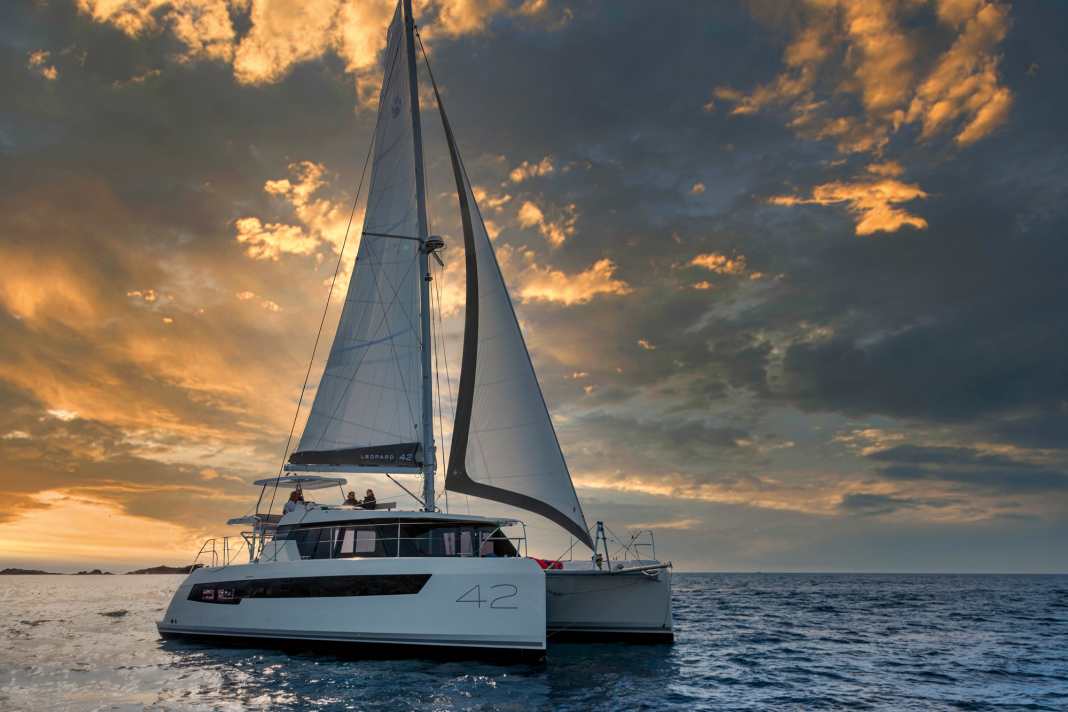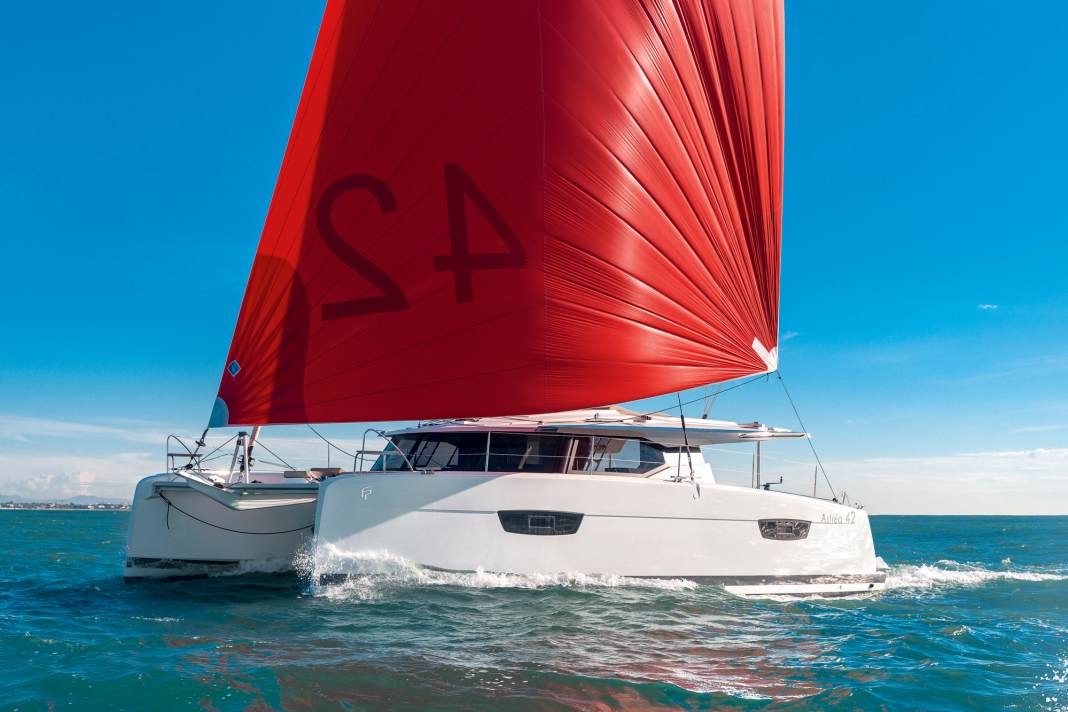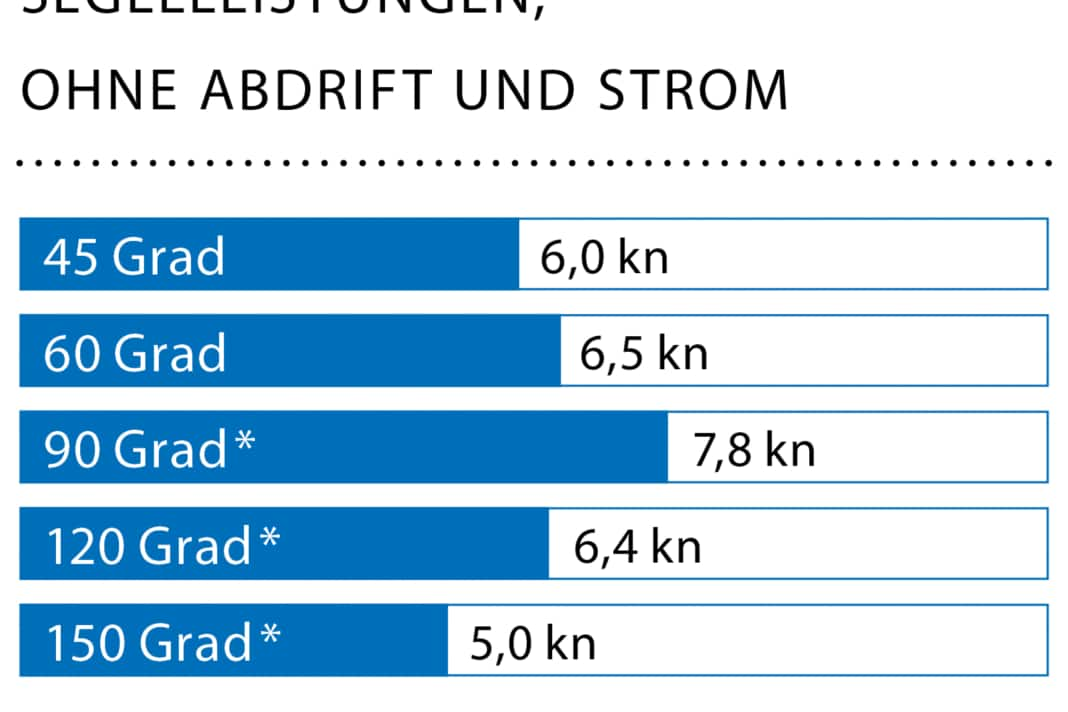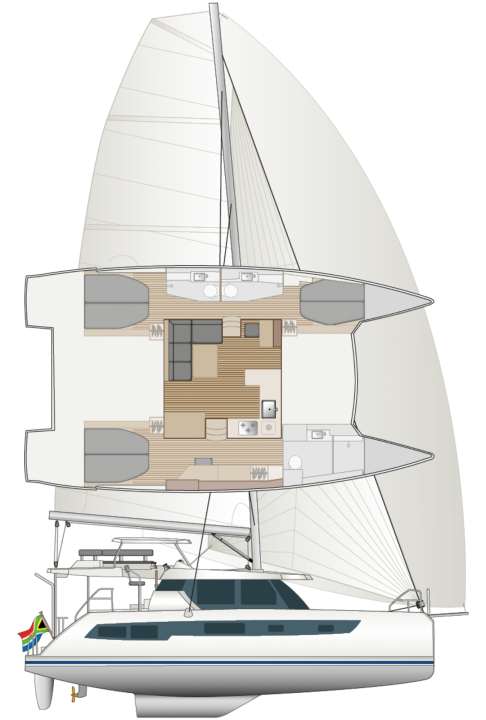Leopard 42: Catamaran surprises with good sailing characteristics in the test






The market has recently changed significantly, says Arnaud Savignat, Sales Manager for Leopard Catamarans in Europe. Until a few years ago, around 70 per cent of the entire production was sold directly to yacht charters, but today around half of all boats built by Leopard are sold to private owners. One of the reasons for this change is the apparently lucrative buy-charter model for interested parties.
This means that private individuals buy the ship, but initially have it rented out for a certain period of time via reputable charter companies and receive monthly payments in the form of a return. During the fixed term, the charter companies take care of the mooring fees, care, maintenance and insurance. In addition, the owner may also use the boat himself, but only during the periods agreed in advance.
These financing models, which are apparently being installed more frequently again, are real sales drivers for the manufacturers. Of course, they are not only available for Leopard catamarans, which are built by Robertson and Caine in Cape Town.
Touring boats on two hulls: the competition of the Leopard 42





With around 200 units per year, the shipyard is one of the market-leading producers in the industry and is a strong competitor to major brands such as Lagoon and Fountaine Pajot. Around half of the production goes to the USA because the distances are shorter and delivery is easier. The catamarans usually arrive in Europe as deck cargo on a freighter or are transferred, which costs additional money. And not just too little: around 30,000 euros are added to the basic price for delivery to Europe. What buyers need to know.
Manageable programme
The Leopard 42 has now been presented by the shipyard as a replacement for the Leopard 40. However, with a hull length of 12.67 metres, the new ship is around 70 centimetres longer and correspondingly wider than its predecessor. This means that Leopard is initially leaving the entry-level class of 40-foot hull lengths and is instead joining the next largest segment of 42-footers, which is now more up-to-date with newer models - a logical step with regard to the competition.
For the concept, this means significantly more space and more living comfort in the hulls as well as extension versions with up to four cabins, each with four associated toilet rooms and at least semi-separate shower rooms. This now corresponds to the class standard for 42-footers. As with its competitors (Fountaine Pajot Astréa 42 and Lagoon 42), Leopard has now also dispensed with the option of an additional skipper's cabin in the forepeak, which was previously still available.
Built exclusively in South Africa
Robertson and Caine's programme is much more manageable than the lines of the dominant catamaran brands in France. There are currently only three boats in the shipyard's portfolio with lengths of 42, 45 and 50 feet. Fountaine Pajot, on the other hand, has seven models in its programme, ranging from 40 to a maximum hull length of just under 70 feet; and market leader Lagoon currently offers no fewer than ten models in a similar length range.
The Leopard boats are built exclusively in South Africa, and all parts are built entirely using the vacuum infusion process as sandwich constructions with a foam core, vinyl ester resin for the outer layer and polyester resin for the laminate structure on the inside. Only below the waterline, in the area of the rudder shaft and under the fittings on the deck is there a full laminate. In addition, the shipyard integrates a steel crossbeam in the forward beam as a structural connecting element for further stiffening and to avoid too much torsion between the hulls; this is generally an important issue for catamarans. The ballast-free keel stubs are only glued to the hull, not screwed or laminated. They are designed to shear off in the event of grounding without damaging the structure. Nevertheless, they are so strong that the boat can be parked on them without any problems.
Nimble feline predator
The Leopard 42 is available to the YACHT editorial team for a test in Saint-Raphaël on the French Côte d'Azur. With the typical wind and weather conditions: lots of sun, but only a little wind around ten knots (3 Beaufort), sometimes a little more. With the simple standard sails (overlapping genoa, fully battened mainsail), the design from Studio Simonis/Voogd gets going quickly and well, logging 6.0 knots through the water and tacking at an angle of 90 degrees. These are surprisingly good figures for a pure cruising catamaran with little claim to special performance and sportiness.
The South African also impresses with its lively manoeuvring characteristics. Turns can be manoeuvred quickly without losing much speed. And with a total weight of 12.5 tonnes, the relatively heavy ship responds quickly and immediately to the rudder. This also applies to operations under engine power in the harbour, where the Leopard 42 with its two 45 hp built-in engines can be moved easily and as required. The two saildrives are installed in front of the rudder blades and are therefore more effective for forward thrust. Underway under engine power, the cat reaches 9.4 knots under full load, and at cruising speed (80 per cent of maximum speed) it still reaches 8.5 knots.
Leopard 42 is suitable for single-handed use
Even with the Leopard 42, steering under sail is not a pleasure that requires a lot of feeling, but is reduced to mere steering and course keeping, which is more or less the case with almost all cruising catamarans. In practice, therefore, the autopilot usually takes over anyway. However, if you want to steer the Leopard yourself more often and for longer periods, the wheel on the steering position is mounted too low, especially if you want to sit on the high bench. It is easier to steer standing up, behind the wheel or to the side of it. However, there is then a lack of overview, especially when manoeuvring in the harbour.
Handling halyards, sheets, cleats and winches is effortless. The layout is very well thought out and also one-handed friendly. This is a definite advantage on the Leopard 42, as there is very little space at the helm and it is already very cramped for two people. Handling is made easier thanks to very high-quality basic equipment with powerful stoppers, large Lewmar winches and properly dimensioned blocks and rollers. This is part of the Leopard construction standard.
Exclusive with rooftop lounge
One of the three winches is electrically operated from the shipyard; motors are available as an option for the others, which is recommended. This is because the standard genoa, which overlaps quite widely, and the mainsail, which is flared wide at the top, develop high loads even at medium wind speeds, which can only be tamed with the winch handle with great effort. Incidentally, the mainsail is trimmed using two separate bulkheads, which compensate for the function of the unfortunately non-existent traveller on the bimini. Although the Hahnepot system is simple, efficient and cost-saving, it also means extra work because the mainsail has to be trimmed again and again after manoeuvres. Only active sailors will really like this.
The dedicated lounge area on the flybridge is exclusive to the Leopard 42 in its length class. Its direct competitors from the larger product series only offer sun loungers on the upper floor. The airy and panoramic seating area on the roof can only be reached via the stairs on the port side, but not from the opposite side from the helm station. So if the helmsman needs to get to the roof quickly to clear something, for example, he either has to undertake a daring climb or sprint around the cockpit to the stairs on the other side.
Expansion according to class standard
The buyer has the choice of interior fittings. The owner's version has two cabins and two heads on the port side as well as a long, separate master cabin on the starboard side with a desk, more storage space and a large bathroom including a shower in the foredeck. On the variant for charter use, the hulls are built identically, i.e. with a total of four cabins and four toilet rooms. This variance corresponds to the norm within the 42-foot touring cat class; there are no longer any significant deviations from this.
The entire 42-foot class is also largely homogeneous in terms of the general layout in the central saloon. The standards are defined with a seating area and a flexible table, a large galley and a chart table. In the Leopard 42, the galley is positioned towards the front, with an almost unrestricted view in the direction of travel through the huge windows in the superstructure. This is particularly convenient when travelling.
Unlike on the boats from Fountaine Pajot or Lagoon, the galley of the Leopard is therefore not functionally linked directly to the dining area in the outside cockpit, where you usually spend more time than inside in the saloon - a compromise. The navigation is also forward-facing and can be used as an inside helm station via the remote control from the autopilot in bad weather. From here you actually have a complete overview of the ship, forwards and to the side, as well as through a long window in the cabin roof even into the rig including the mainsail. However, engine control in navigation is not available as an option from the shipyard.
Unstoppable through the sea
What is completely missing in the saloon are handrails, recessed grips or edge mouldings on the furniture. Anyone who sails the Leopard in rough conditions will look in vain for support here. This issue is often neglected on catamarans in general, but even here it can be quite uncomfortable in swell.
On the other hand, the Leopard scores points with a very good solution for lowering the saloon table and converting the seating area into an additional double berth with inlay cushions. The table is extremely solidly anchored and the additional cushions are supplied as standard. The large sunbathing area is also suitable as a day berth for long passages on the high seas with a good view to the outside.
Leopard 42 gives away space
If the hull is fitted with two cabins, the berth, which extends far forward, becomes quite narrow. The shipyard wants to design the berth as an island bed here too - probably for visual reasons - and thus unnecessarily wastes space at the sides. In fact, the berth, which is designated as a double berth, is just 1.12 metres wide at shoulder height, making it very cramped for two adults.
On the competitors and on the predecessor model Leopard 40, the bunks at the front are wider and more comfortable for double occupancy. On the other hand, the beds aft, with a width of just under 1.70 metres, are much more comfortable for sleeping, even for two people. As far as ventilation is concerned, the Leopard 42 is a role model. There are several large openings in all cabins below deck, in the toilet rooms and also in the saloon, so that all areas of the boat can be ventilated crosswise.
When it comes to the technical installations, the ship from South Africa can also play its trump cards in comparison with the competition. The wide range of components for the water circuits, electrics and built-in machinery, which are typical of a cruising cat of this size, are immaculately installed, clearly labelled and easily accessible.
It is understandable that Leopard Catamarans demands a little more money for the clean construction, the solidly manufactured structures and the high-quality fittings on deck. However, with a base price of 629,510 euros, the South African is only marginally more expensive than the boats of its direct and comparable competitors. As already mentioned at the beginning, however, buyers in Europe must factor in a hefty delivery fee - unless they are transferring the boat themselves.
Attractive alternative
Leopard boats are a must for anyone interested in attractive, modern catamarans, whether as an owner or a charter company. The Leopard 42 will certainly not make it any easier for the predominantly French competition, but positions itself as an attractive alternative. The fact that the big cat from the Cape of Good Hope also sails well is a welcome bonus.
The measured values for testing the Leopard 42




The Leopard 42 in detail

Technical data of the Leopard 42
- Designer: Simonis/Voogd
- CE design category: A
- Torso length: 12,67 m
- Width: 7,04 m
- Depth: 1,40 m
- Weight: 12,5 t
- Mast height above WL: 20,68 m
- Mainsail: 66,6 m²
- Furling genoa: 46,4 m²
- machines (Yanmar): 2x 33 kW/45 hp
Hull and deck construction
All parts built as a GRP sandwich using the vacuum infusion process. Steel beams in the front beam for more rigidity
Price and shipyard
- Base price ex shipyard: 629,510 € gross incl. 19 % VAT.
- Guarantee/against osmosis: 2/6 years
As of 3/2024, how the prices shown are defined can be found here!
Shipyard
Robertson and Caine, Cape Town (RSA); www.robertsonandcaine.com
Distribution
YACHT rating of the Leopard 42
An exciting alternative for the medium-sized cruising catamaran market, built in South Africa. The very voluminous and comparatively heavy ship surprises with good sailing characteristics, even in light winds
Design and concept
- + Partly covered flybridge as standard
- + Reasonable price
- + High-quality construction
Sailing performance and trim
- + Lively sailing characteristics
- + Suitable for one-handed handling
- - No Traveller available
Living and finishing quality
- + Bright, cosy interior design
- - Very narrow berth in the foredeck
- - Few holding options
Equipment and technology
- + High-quality deck equipment
The article first appeared in YACHT 16/2021 and has been updated for the online version.

